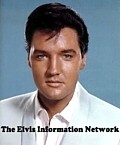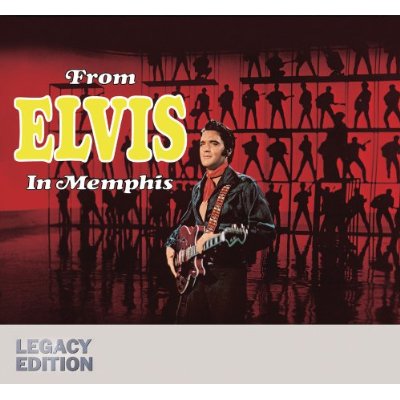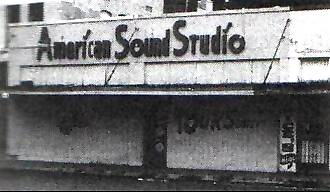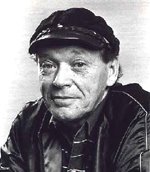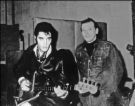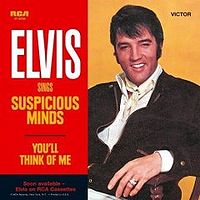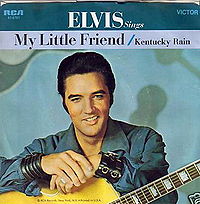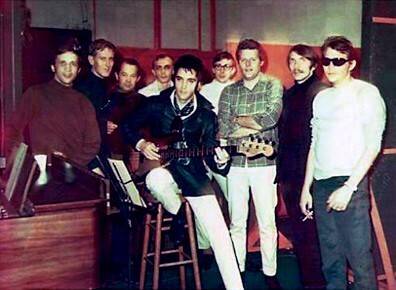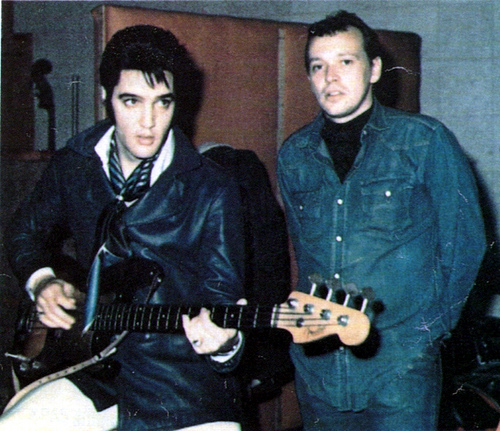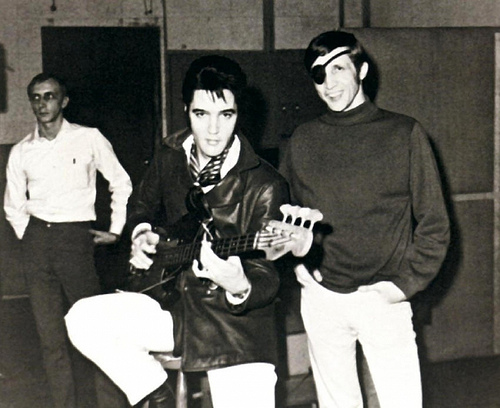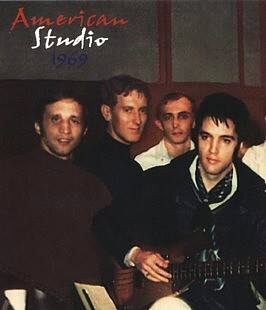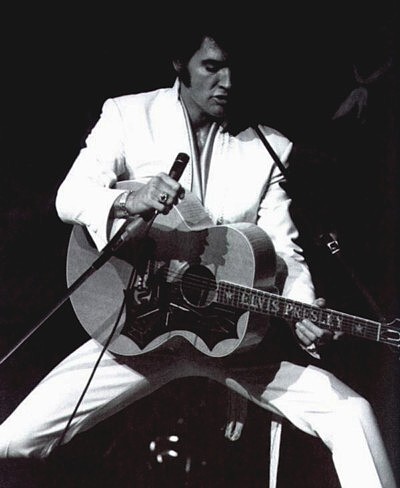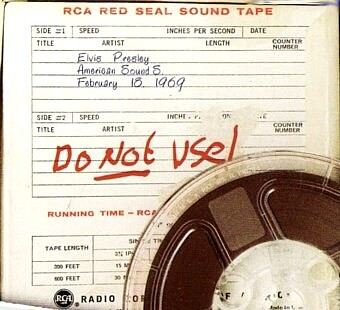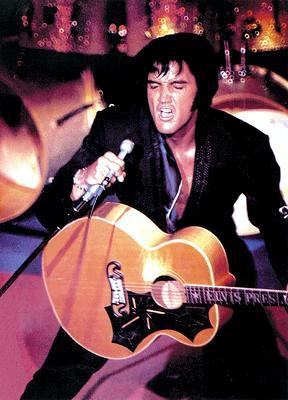 |
 |

What was Elvis thinking in 1969? The ‘happy days’, bobby-soxer’s, poodle skirts and sock hops of the 50s had come and gone, music in the 60s largely passed by Elvis the film star as the British invasion sidelined rock ‘n’ roll, and by the turn of the decade, political activism had taken an important step forward in opposition to an unnecessary and unjust war. Led Zeppelin released their first groundbreaking heavy metal album; in the wings, Ziggy Stardust was taking interplanetary shape; while somewhat closer to home, man landed on the moon. Elvis must have been in great spirits in 1969! His deteriorating film career was to his great delight, finally coming to an end; he had married Priscilla and Lisa Marie (the joy of his life) had been born; he had lost weight and was looking tanned and very fit; and his return to live performance was imminent. Despite this, Elvis was a man full of self doubt! No longer was there any real interest in the latest Elvis film so was the King still relevant? His 1968 Christmas TV Special had proven to be a hit but could the King build on this, and if so, how?
Chips Moman was a legendary figure in contemporary music at the time. He was the most successful producer in the Memphis region and his studio house band, the Memphis Boys, were not only first rate, they were arguably the best going around. Moman’s American Sound Studio (singular) was situated 827 Danny Thomas Boulevard. The studio was of all things, a converted dairy in one of the most neglected and economically challenged parts of Memphis. As noted by Elvis biographer, Jerry Hopkins, in his seminal “Elvis”:
Elvis would record in the studio over ten nights between 13 January and 22 February 1969. In that time he cut 36 tracks. For 4 days Elvis had laryngitis but what should have been a debilitating force only enhanced his recordings. The result was, excluding budget releases, Elvis’s 34 th album for RCA. While the weather was bitterly cold in Memphis that winter, inside 827 Danny Thomas Boulevard the heat of Elvis’s recording sessions would have melted an Antarctic glazier! In fact, these are the sessions which could have saved the RMS Titanic, had Elvis only been born 50 years earlier and decided to record on the unsinkable luxury liner in April 1912. From Elvis In Memphis explores a complex and satisfying musical landscape. From rugged mountain ranges to lush green valleys, winding though dusty gravel roads to towns with colourful fairs and white picket fences hiding families in crisis; death and alienation – the potent themes resonate powerfully like a raging Tennessee tornado though Elvis’s assured vocal and a wonderfully produced musical cocktail. First love; strength of character and the cyclical defeat of life in the ghetto – the results of From Elvis In Memphis are why Elvis became, not only a professional singer, but also the best of his generation. At the same time, Elvis reclaimed his position as the world’s most exciting live performer as he not only conquered Las Vegas, but redefined what greatness meant in ‘bright lights city’ (the Rat Pack was replaced by a hipper, more inspiring performance model) and he would soon embark on an equally triumphant series of largely one night “Roman” stands in huge coliseums across his beloved America! But I digress. Vic Anesini’s masterful audio work on From Elvis In Memphis means Elvis’ vocals are noticeably clear compared to the excellent 1999 Suspicious Minds: The Memphis 1969 Anthology release (which admittedly contains alternate takes, unlike the more pristine From Elvis In Memphis Legacy edition) and particularly so compared to 1987’s well received but now musically primitive, The Memphis Record. What also adds to our aural experience is a better feel to the backing instrumentation along with a real audio depth to these new versions. The bass is lovely and clean while a new level of high frequencies are present adding an amazing crispness to top end. The pulsating horns during the closing stanzas of I’m Movin’ On are fabulous while the left channel guitar twang on Wearing That Loved On Look grabs your attention. On After Loving You, the stunning clarity of drummer Gene Chrisman's cymbals is a real treat. And at the start of In The Ghetto you can even hear the tension of the bow as it plays across the cello strings! There is also the added bonus of the Original Mono Single Masters. So much media attention has been recently given to The Beatles new Mono Masters releases that it is a shame that Elvis fans aren't similarly impressed. These are the MONO classic singles that took Elvis back to the top of the charts and helped him regain his iconic status. Suspicious Minds was never released in stereo in Elvis' lifetime! These Mono Singles were the key studio mixes of the time, designed to blast out of radios at home and in the car and make the general public sit up and take notice. Far more time was spent by the studio engineers getting the mono mixes just right than on the Stereo LP versions. They were produced so that the sound would jump off the 45rpm single or really punch out of the radio systems. In general they had a more prominent mix to Elvis' vocal, as well as more bass end and with a lot of audio compression. Some of the Stereo mixes of the same songs sound very "thin" in comparison. So to have them released here for the first time on CD is a real bonus. There are also plenty of genuine differences in the mixes (detailed below) but if you want to notice the real difference, then try playing them in your car against the other stereo versions. They really do jump out at you. This is after all what the Sony Legacy is all about.
The 2LP Memphis Record release in 1987 was a welcome release with several tracks including Suspicious Minds (sans fade out/fade in), Wearin’ That Loved On Look and Gentle On My Mind featured as alternate mixes & vocals. However it had a very "eighties sound", with overdone treble & bass and a very narrow stereo-spatial mix, so in 2009 its sound is almost primitive in comparison to that on the latest offering. Similarly, the 1999 Suspicious Minds double album was also a strong release for its time, but does not compare to the 2009 volume. That Elvis was re-invigorated on entering the American Sound Studios in July 1969 is well documented. Equally significant was Elvis’s willingness to immerse himself in an eclectic range of powerful, contemporary and importantly, meaningful music that he twisted, stretched and refashioned with soulful emotional intensity to make it his own and signify his return to the throne after a self imposed exile to complete contractual obligations as an intrepid adventurer in exotic locations with a bevy of beautiful women and a not so bountiful collection of songs. Gone were the days of loathing his flaccid film commitments with their equally dire, trite songs. Those present during the sessions have consistently commented on Elvis’s energy and enthusiasm, his revitalised drive to again record powerful music. Sidebar - What others say about From Elvis In Memphis (40th Anniversary Legacy edition):
The element contributed by his stellar Memphis Boys should not go unnoticed.
Chips Moman however would employ other notable names for his backing-vocals overdub phase, including vocalists Millie Kirkham, Ronnie Milsap (on Kentucky Rain), and Sandy Posey (famous for her hit single, Single Girl) along with Mary Holladay, Mary Greene, Donna Thatcher, and Ginger Holladay. The Memphis Horns were also used including Wayne Jackson ( read Wayne’s interview with EIN) plus numerous others, including R.F. Taylor on trumpet; Ed Logan on trombone and Joe D’Gerolamo on the French horn, were part of something special, even if many of them did not realise it at the time (such are the vagaries of making music). Great Right-Left channel separation means both backing vocals and instrumentation complement Elvis's searing vocals to perfection. Listening to the tracks recorded by Elvis over 10 nights in January and February 1969, the Chips Moman factor is obvious. Post production work would see Chips add another wonderful element, superb overdubs by the Memphis Horns, and on many tracks these would shine. Unfortunately, the potency of these overdubs has not been fully evident since 1969. That is until the Legacy edition of the From Elvis In Memphis sessions in 2009!
The sound made between Elvis, his backing vocalists, the Memphis Boys and the many overdub musicians is totally in the groove, gelling wonderfully to produce an formidable and undeniable part of music history. A tradition at Moman’s studio was for each artist to pay tribute to the chief with a rendition of “This Time”, a Chips Moman penned hit for Troy Shondell in 1961. As Jorgensen noted, Elvis observed the tradition, and only knowing a few lines of the song quickly segued into It’s My Way, a song by Don Gibson. As a complete session, the From Elvis In Memphis recordings are not perfect, but there again which sessions ever are? (EIN Note: Producer Chips Moman has stated that he only considered releasing one album of songs at the time and that the weaker tracks were never supposed to have been issued.) However, Elvis in January & February 1969 came close to perfection, much like he had similarly done in another small, near claustrophobic, studio in Memphis in 1954-55. Listening to Elvis, suffering from an obvious cold which at times made his voice quite raspy, and in itself adding potency to the finished recording, the listener cannot help but be struck by the musical vibrancy, vocal flexibility and gut wrenching passion that Elvis wrings out of his work. This is confronting stuff to be relished as it is greatness which does not come along very often. And even on what some would consider may be weaker songs from the session there is still Elvis’s customary professional interpretation. Rarely in his career was he too lazy to provide a finished product below par.
Elvis and pianist Bobby Wood, with drummer Gene Chrisman, at American Sound Studio Sidebar - What others say about From Elvis In Memphis (40th Anniversary Legacy edition):
The freshness of Anesini’s potent remastering literally steams out of the ballsy Stranger In My Own Home Town, a recording profusely oozing sophistication and class. In fact, Elvis’s take on Stranger In My Own Home Town is classic soul blues. Gnawing to the bone, Elvis’s vocal draws fervent commitment, which Jorgensen suggests had its genesis in Elvis’s intensive listening and home recording in 1966, as he slowly rediscovered his own musical foundations.
Elvis loved Mama Liked The Roses, an over orchestrated ode to the late Gladys, and while not a highlight of the American Studio sessions, it has struck a chord with many Elvis fans with its reverential tribute to the eternal mother figure. There is also the gospel treat, Who Am I, a reflective internal search for essentially the meaning of life as defined by the restrictive doctrine of religious hierarchy and texts. Remember that song by Neil Diamond Elvis agreed to record in return for Diamond shifting his dates in the Chips Moman studio? The result was a faithful interpretation of one of Diamond’s lesser known, but engaging songs, And the Grass Won’t Pay No Mind. Amusingly - and showing Elvis' great feeling while recording at American Sound - Elvis is reported as having playfully sung at the end of that night’s session, ‘And you can hear Chips calling’, in place of ‘And you can hear God calling’. He was indeed in good spirits! This great outake can be heard on the FTD Memphis Sessions.Suspicious Minds is regarded by many as Elvis’ greatest ever single. This is auspicious, as his seminal mid 1950s recordings are surely the epitome of his young, raw and largely unbridled talents. Regardless of one’s view, this classic beat ballad with its innovative fade out/fade in tag at the end is undoubtedly one of the greatest pop songs of the 60s decade. Beautifully produced (and sounding so on the Legacy edition of From Elvis In Memphis), it ebbs and flows with sensitive emotion, vocal power and melodic genius. Elvis’s recording came towards the end of his American Studios booking. Eddy Arnold was a major influence on Elvis. Like another balladeer, Dean Martin, Arnold exuded that smooth vocal ability and assurance which only a handful of artists can convey. Elvis chose Arnold’s I’ll Hold You In My Heart (Until I Can Hold You In My Arms) recording for his American Sound Studio sessions. A sublime track which builds without peaking, its success rests on its interpreter connecting with the meaning of its poignant lyrics. Elvis is obviously in tune with this song as he well and truly hits the mark vocally and interpretively. As was Elvis throughout his lifetime, there is an almost curious duality or split personality to his American Sound Studio recordings. On considering the full breadth of the music Elvis recorded on those cold, hazy nights in Memphis, one is struck by the variance of the songs on display. Little needs to be said about the “singles” from the sessions. With several #1 hits and even more top 10 hits, the 1969-70 period for Elvis on the singles charts rejuvenated his iconic status in the world of rock music. Along with the magical Beatles (soon to disband) and John Fogerty’s heady swamp rock concoction through Creedence Clearwater Revival, Elvis once again dominated charts and jukeboxes around the world. Reflecting the eclectic nature of the sessions, the classic singles In The Ghetto, Suspicious Minds and Don’t Cry Daddy resonate very differently to the equally impressive soul infused Wearin’ That Loved On Look, ball busting blues of Stranger In My Own Home Town and soaring beat ballad, Only The Strong Survive; while lighter ballads like The Fair’s Moving On and It Keeps Right On A Hurtin’ suggest they served an important function at the time in giving Elvis a break from his more involving and taxing material. Just as the sportsman warms up by slowly stretching different muscles, Elvis, the musician, was paying due diligence to the importance of the overall recording moment by ensuring he kept himself fresh by massaging his sore vocal chords with a soothing musical tonic in between his engagement with even greater greatness.
The hidden gems from the July 1969 sessions are important. You’ll Think of Me, written by Mort Shuman who was responsible for many Elvis recordings in conjunction with Doc Pomas, is an underrated classic with Elvis in particularly poignant form as he inhabits every nook and cranny of the heartbreaking loneliness of the lyrics. The sessions were also interesting for the use of Young’s electric sitar, an unusual instrument for an Elvis recording session, but one which was used to great effect on the You’ll Think of Me recording. On the Burt Bacharach-Bob Hilliard penned, Any Day Now, the blend of Elvis’ searing vocal with exquisite backing vocals and the songs’ inherent wax and wane beat almost singlehandedly eradicates the musical barrenness and lost opportunity which typified many of Elvis’s recordings in the 1960s. You can almost feel Elvis flying away with the beautiful bird which underpins one level of the song.
Elvis live in Las Vegas 1969 (from the Paul and Joan Gansky Collection) The musical riches put down on tape by Elvis and his musicians in July 1969 are staggering. You can sense how he agonised over many of these recordings, as he challenged himself after years of self doubt and pushed himself to even greater creative heights. He was incredibly focused, an artist on a mission to reclaim his rightful spot at the top of a very crowded and bountiful recording tree. It was a new era, with new sounds and a new political beat, but it was one Elvis had to prove he was still relevant to. Sidebar - What others say about the From Elvis In Memphis sessions:
The sessions were without question, one of Elvis’ golden periods in the studio. Producing hits like In The Ghetto, Suspicious Minds, Don’t Cry Daddy and Kentucky Rain, Elvis’ golden output propelled him once again to the top echelons of the music charts and placed him firmly in the public eye. Even the up-tempo foot stomper, Rubberneckin’, at the time unfortunately and (some say) incongruously buried as the ‘B’ side to Don’t Cry Daddy or the reflective My Little Friend, itself the ‘B’ side of Kentucky Rain, offer something special and serve to further symbolise Elvis’ unparalleled ability to interpret the most varied of musical styles. Rubberneckin’ may not be the greatest song Elvis ever recorded, but it is fun, and it was subject to a not so successful remix following the phenomenal international success in 2002 of A Little Less Conversation (Elvis vs. JXL).
In American Studio:Elvis and backing vocalists Mary Holladay, Mary Greene, Donna Thatcher, and Ginger Holladay - Circa Jan 20 1969. - (From FEIM booklet)
The push for Rubberneckin’ came from songwriter, Ben Weisman, who had submitted the tune his wife’s name. Needless to say, it took Elvis only two takes to finish the track. Perhaps fittingly, or perhaps incongruously, it ended upon as one of the musical highlights in Elvis’ final narrative film, Change of Habit. Liner notes authors, Robert Gordon and Tara McAdams, observe that even Elvis’s ballads “have energy”, and they’re not wrong! Be it country standards like From A Jack to A King or Johnny Tillotsen’s It Keeps Right On A Hurtin’, Elvis shows why they call him the King! Sidebar - What others say about From Elvis In Memphis (40th Anniversary Legacy edition)…..not everyone reveres the Legacy release:
Of interest, Lamar Fike tabled several songs for Elvis to record. While generally accepted as being Nashville fodder, Elvis put down tracks for My Little Friend and Inherit the Wind and a backing track was recorded for Memory Revival. However, Fike scored big for Elvis with the singles hit, Kentucky Rain, written by Eddie Rabbit, who had also written Inherit the Wind and would subsequently pen the up-tempo, Patch It Up (an audience favourite on Elvis’ return to live performances). At the time it was becoming far from a rainy night for the upcoming country music star. Elvis apparently knew only a few lines of Hey Jude, and while the finished product reflects this, the 2009 release of From Elvis In Memphis showcases his recording to its fullest. Earlier releases have not properly reflected Elvis’ commitment or interpretation of the Beatles classic song, but the Legacy edition of From Elvis In Memphis presents it in a very different and positive light. And all the criticism about the Mono Masters being included on From Elvis In Memphis is unwarranted (as all true audiophiles will tell you). They sound as crisp and fresh in 2009 as they did on original release in 1969. The sound is full, rich and in many ways better than it was in 1969 when then audio engineering capabilities and consumer record players could simply not do the music full justice. But in 2009 these issues are well and truly overcome. The exception to this is listening to the mono masters on your iPod or MP3 player. This medum does not do justice to their sound. Sidebar - EIN's Piers Beagley on the inclusion of the Mono Masters:
It will also please many fans that the Legacy edition of From Elvis In Memphis recreates the original album releases from 1969-70.
In reflecting back on the original track listing for the original From Elvis In Memphis, one is struck by the omission in excluding the hits Suspicious Minds; Don’t Cry Daddy and Kentucky Rain. A missed opportunity, but with hindsight, probably not a surprising one. Some critics have attempted to devalue the merit of the sessions by drawing attention to the variance in music genre recorded by Elvis. In so doing they ignore one of the underlying drivers that makes Elvis the recording artist he is! Elvis’s personality dictated that he became bored very easily. His early recordings demonstrated that he was a litmus paper, instinctively absorbing, rearranging and redirecting various different musical influences to provide a new musical landscape on which the rising, younger audience, could satisfy its long repressed needs. With Elvis it was always a case of ‘something for everybody’. In the case of the American Sound Studio sessions it was a molten, hot lava of contemporary country music intertwined with energetic ballads, powerful blues, heartfelt gospel, all capped off with a heavy dose of contemporary soul. What a heady, sensory challenging mix! Elvis proved in January and February 1969 that he still understood music! He recognised great material and just as importantly he could sing, mould and make that material not only his own, but also POWERFUL and RELEVANT! Be it rock, blues, funk, soul, ballad or country pop, the King was back and, with the possible exception of his How Great Thou Art sessions in 1966, he delivered like he hadn’t in over a decade. His internal feelings of unbridled freedom and expression must have been exhilarating!
Counter intuitively, in many respects it was a case of what might have been. Alternatively, it was the bursting of the pressure valve which had restlessly simmered, internally ruminated and eventually spewed forward like a once dormant volcano, longingly rumbling to be set free and coat the land with its pent up transforming force. Sidebar - What others say about From Elvis In Memphis (40th Anniversary Legacy edition):
In his earlier book (with Erik Rasmussen and Johnny Mikkelsen), Reconsider Baby – The Definitive Elvis Sessionography 1954-1977, Jorgensen and co. observed under “Collector’s Notes”: “As a consequence of the recording procedures in the Memphis Studio on the whole there exists only one rhythm track of each song, making this rather barren territory for the collectors.” The author’s comment, made in 1984, could not have foreseen the technological advancements in recording technology which would transform contemporary listening pleasure in the 1990s and to today. The 2CD digipack fold-out comes with a 28 page booklet full of interesting liner notes by rock identity, Robert Gordon (The Elvis Treasures) and Tara McAdams (The Elvis Handbook), and rare color visuals from the sessions. (go here for more inside images) The cover artwork carefully reflects the original artwork, with the follow up album cover, Back In Memphis featuring in the first digipack foldout. Also reflecting the design at the time, the discs feature the yellow RCA label used for the From Elvis In Memphis sessions albums. Underlying the two disc slots are reproductions of the two biggest singles covers from the sessions: In The Ghetto and Suspicious Minds. As From Elvis In Memphis is a release you will play often, extra care will be necessary with its cardboard, digipack packaging. Several of the photographs are anachronistic, but fans won’t complain about seeing Elvis with Fats Domino or Frank Sinatra and daughter, Nancy (who co-starred with Elvis, albeit disastrously, in Speedway).
Verdict: When being asked to buy the latest incarnation of an already numerously issued and reissued album, you want to be assured you are acquiring a product which goes beyond the earlier incarnations and adds value for you as the listener. In this respect you need not worry. The value-add provided by From Elvis In Memphis (40th Anniversary Legacy edition) is delivered in spades! Glorious, remastered sound, expertly produced by the legendary Vic Anesini and some of Elvis’ greatest studio work add up to a ridiculously pleasing aural pleasure spread across 2 great discs. Anesini is renowned in the Elvis world for his exemplary remastering work. With the Legacy edition of From Elvis In Memphis the carefully orchestrated channel balance nicely accentuates the different parts which make up a bigger whole. This balance is noticeable on both and higher quality audio systems. Short of total remastering using DSD or beyond technology for the 50th Anniversary edition, it will be hard to beat the sound produced by Vic Anesini with this release. Sit back, put on your headphones and drift away to far away exotic places as you savour almost 2 hours of the King at a seminal, creative peak. Elvis would never approach this level of creative genius again in the recording studio. His career was still to experience one final artistic high (Elvis: Aloha From Hawaii), but after the 1969 American Sound Studio sessions it would never really be the same again. From Elvis In Memphis is indeed a piece of recording history! (CD Review, Source: The Phantom) Playing time: CD 1: 50:20 CD 2: 1:03:46 The American Sound Studio "Elvis" catalog: 1969: From Elvis In Memphis (single LP) 1969: Back In Memphis (single LP) 1987: The Memphis Record (2LP) 1999: Suspicious Minds: The Memphis 1969 Anthology (2CD) 2009: From Elvis in Memphis (40th Anniversary Legacy edition) (2CD)
The SONY 'F.E.I.M Legacy' double-cd release is available for only $12 from Amazon - and in Australia for AU$25 from your local JB HiFi. Every Elvis fan should purchase this quality bargain, and get Elvis back in the charts.
Elvis Vegas '69 may prove to be the perfect complement to From Elvis In Memphis: read all about this great new book by Ken Sharp For another perspective on Elvis’ American Sound Studio sessions visit Stephen Rudko’s: Reinventing Elvis: The American Sound Studios Sessions: http://www.furious.com/perfect/elvis69.html And for more on the American Sound Studio sessions check out EIN's informative articles: 'From Elvis To Garth' Bobby Wood & The Memphis Boys; 'In The Ghetto' - The 40th Anniversary: Chips Moman's American Studios - A Turning Point In History': EIN Review of FTD - Memphis Sessions EIN Website content © Copyright the Elvis Information Network. .
. |
|
